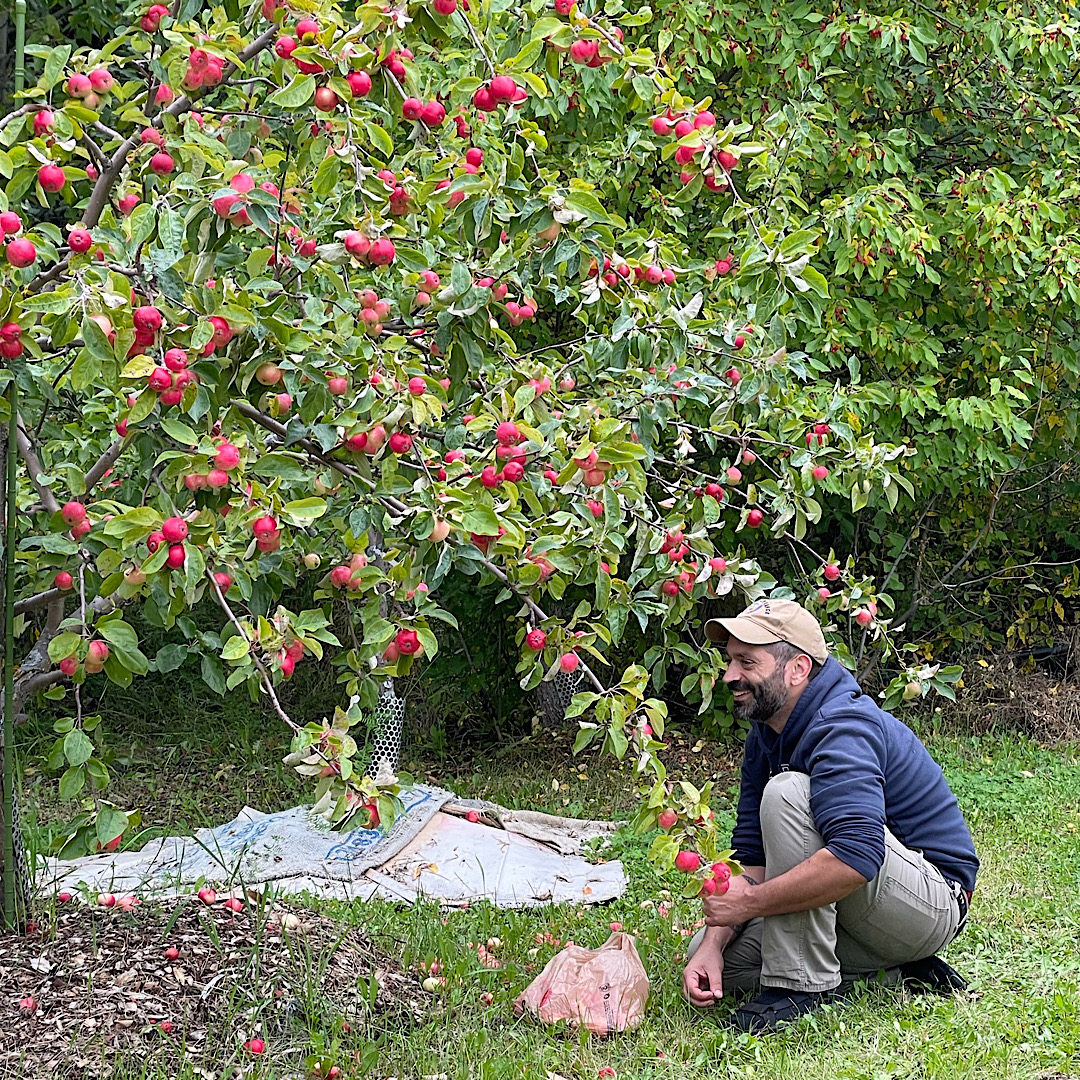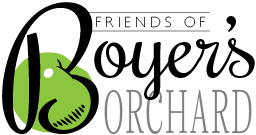
Started in 2022, Sponsor-A-Tree is a great way to help contribute to the orchard, learn more about fruit tree production and care, form a longer-term connection with a specific tree, and of course, celebrate the fruits of your labor! We encourage families, groups of friends, co-workers, and small businesses to go in on a tree sponsorship together.
Overview:
Sponsored trees are marked with a tag with the sponsor’s name. Individuals or groups can sponsor a tree during the spring and are responsible for tree care throughout the season and harvest in the fall.
Sponsorship Requirements:
-An affinity and appreciation for apples
-Time and energy to devote towards tree care including the ability to visit your tree several times throughout the season, as well as harvest the apples in the fall. We ask that sponsors commit to a minimum of three visits to their tree per season. (pruning or blossom visit, mid-summer maintenance, and harvest)
-An adoption fee of $250
Sponsorship Benefits:
-Anchorage-grown apples! Selected trees produce between 40-100 pounds of fruit
-Tree-care maintenance skills – training and practice
-Connections to our apple-growing community
-Apple production varies from year to year, but we guarantee that each team takes home a minimum of 50 pounds. If your tree does not meet this minimum you may supplement with apples from our fall sales. You may also donate the apples you harvest to the orchard for sale if you do not wish to keep them all
Additional Notes:
-Pruning dates will be announced in late Winter/Early Spring Each year
-Fall Harvest Dates will be announced in late summer
-We are happy to provide pruning shears/loppers, ladders, and guidance
Optional Tree Study:
While not required, we encourage you to join in the study and tracking of your tree throughout the seasons. This is an especially exciting opportunity if you would like to continue supporting the same tree for many years or if you have an interest in learning more about your tree’s history, underlying health, or relationships between things like rainfall, temperature, blossom date, fruit production, quality, etc. By contributing observations such as photos, drawings, important dates, fruit-tasting notes, and more, you can contribute to our shared knowledge and wisdom
Apple Varieties Up For Sponsorship
| Variety | Description/Taste |
| Akero | Akero is a Swedish heritage variety. The flesh is pale cream in color, firm, and juicy with a bit of a tang with raspberry flavors. Tough-skinned. Widely regarded as Sweden’s best-eating apple. Used for fresh eating, does not store well #111 |
| Baldwin | Baldwin is one of the best New England apples and one of the oldest. It is large and conical, with crimson red over a coppery green skin. Its cream-white flesh is crisp and juicy. It is aromatic with a spicy, sweet-tart flavor, and it holds its shape when cooked. #12 (Greenhouse) |
| Beautiful Arcade | Beautiful Arcade lives up to its name. An old Russian apple of good quality. Yellow base color over which are blushes of bright red. Does not keep well in storage. #223 |
| Breakey | The firm, crisp, and juicy fine-grained flesh is whitish with tints of yellow or green. Canada Red is rich and aromatic, it is a very fine fresh-eating apple. The average harvest is around 40/lbs per year #110 |
| Cameo | Cameo’s flesh is dense and creamy white to yellow in color with a crisp and juicy texture. The flavor is the perfect balance of sweet and tart with nuances of both honey and citrus. #20 (Greenhouse) |
| Canada Red | Firm, crunchy, juicy, sweet, with a slightly tart flavor. The creamy white flesh is fine-grained and crisp, with a sweet, nut-like flavor that is great for fresh eating, cooking or making jellies. #128, 210, 415, 617 |
| Carroll | Carroll produces a larger fruit with unusual skin color and shape, earlier to ripen, best for fresh eating. Average production is around 60/lbs per year. #107 |
| Chenango Strawberry | This precocious and vigorous tree bears pleasingly fragrant fruit. Excellent for fresh eating and cooking. Ripens over several weeks; harvest early for best results. Antique variety originates from Chenango, New York, circa 1854 #313 |
| Chestnut Crabapple | Honeycrisp apples are medium to large and characterized by an exceptionally crisp and juicy texture. They can be kept in the fridge for a couple of months after picking. The average harvest is 40/lbs per year. #9, 23 (Greenhouse) |
| Collett | The firm, crisp and juicy fine-grained flesh is whitish with tints of yellow or green. Canada Red is rich and aromatic, it is a very fine fresh-eating apple. The average harvest is around 40/lbs per year #110 |
| Crimson Beauty | The fruit is medium-sized with red and crimson-striped skin. The soft, juicy white flesh is stained with red on the sunny side. Distinctive, fairly acid taste, although fully ripe has some sweetness. Too early, it can be like a green gooseberry. Has a tendency to drop before ripe. #204 |
| Florina | Also called Querina is derived from Jonathan crossed with Golden Delicious and Rome Beauty among others. The apples are very attractive and tend to stay on the tree, allowing picking over an extended period. Sweet, aromatic flavor combined with a crisp, juicy texture, and keeps about three months in the fridge. #46 (Greenhouse) |
| Ginger Gold | Can go biennial, mid-season ripening in Alaska. Keeps well for an earlier apple – several weeks in the fridge. Good all-purpose apple. Average production is around 40/lbs per year. #119, 235, 507, 601, 602, |
| Golden Sentinel | A Yellow Transparent cross, the Lodi apple tree is one of the earliest to produce fruits in the orchard. Apples that are medium to large in size with a deliciously sweet flavor. Not a good storage apple, but they can be sliced and frozen or canned in order to extend the harvest. The soft, creamy flesh is perfect for pies and applesauce. The average harvest is 50/lbs per year. #224 |
| Honeycrisp | Medium-sized and attractive golden-yellow apples are sweet, juicy, and delicious. The fruit is strikingly similar to Golden Delicious apples in both appearance and flavor. The average harvest is 45/lbs per year. #67 (Greenhouse) |
| Iowa Beauty | Not a large tree but produces some massively large apples, a Heritage variety that is not often grown in Alaska. Average production is around 40/lbs per year. We only have one of these trees at Boyer’s. #304 |
| Karmijn de’ Sonnaville | The flesh is coarse-grained, firm, and juicy. Rich and aromatic with intense nutty and honeyed flavor. High in sugar and acidity. Sometimes on the sharp side but mellows in storage. A good eating apple. Also excellent for juice and cider. This variety often wins at the Alaska Pioneer Fruit Grower’s annual tasting event. Average harvest 40/lbs per year #47 (Greenhouse) |
| Lodi | Crisp, juicy sweet with just a hint of tart. Medium to large. One of Yael’s favorite orchard apples. Only one of these is growing at Boyer’s Orchard. The average harvest is around 60/lbs per year #236 |
| Northern Lights | The flesh is striking: extremely white with streaks of red, and slow oxidation. The flavor of the apple will change depending on the harvest date, leaning towards more tartness earlier in the season, and tasting sweeter later on; always well-balanced and delicious, developing a fruity, almost cherry-like flavor. The texture is firm and very juicy. It’s great for fresh eating and cooking. The average harvest is around 50/lbs per year. #116 |
| Oriole | Oriole produces some of the largest apples in our orchard. The apples are colored with orange, yellow, and red. It has a good distinctive flavor and is a great apple for fresh eating as well as cooking. #312 |
| Parkland | Medium-small fruit, early ripening, very consistent, easy to grow. Similar to Norland but keeps better. Bred for short growing seasons and long, harsh winters. Average production is around 75-100/lbs per year. #321, 323, 324, 327 |
| Prairie Sun | The flesh of Prairie Sun is fine-grained, crisp, somewhat sweet, and very juicy. Resistant to browning when cut open. One of the earliest apples to ripen at Boyers, but it does not keep well. The average harvest is around 70/lbs per year #308 |
| Sansa | Sansa is one of the best-flavored and sweetest early-season apple varieties. It is similar in flavor and size to Gala, one of its parents. Like most early-season apples Sansa does not keep and is best eaten straight from the tree. It can be kept fresh in a fridge for a week or so. #28 (Greenhouse) |
| September Ruby | A modern apple variety that ripens later in the season, usually in late September or early October. Medium-sized and round, with a green-blushed brownish-red. The flesh is greenish-white, sharp, and juicy. Great for eating fresh, good in pastry, and excellent for juicing. Sometimes used in cider. #604, 605, 606, 607, 608 |
| Whitney Crabapple | A heritage variety dating back to 1869, Whitney is a crabapple by name only. It is much larger than other crabapples and has a great flavor. It is a good apple for eating fresh or for baking. Makes a flavorful apple jelly, and is also used for cider. #513 |
| Yellow Jay | An Alaskan creation (Palmer, 1960s). Technically a crabapple but a very tasty and extremely productive consistent cropper. Average production around 50/lbs per year. #506 |
| Zestar! | Great crisp taste – The most outstanding feature of a Zestar! apple is its sprightly sweet-tart taste with a hint of brown sugar. Very juicy with a light, crisp texture. Stores well in the fridge for up to two months. #29 (Greenhouse) |
